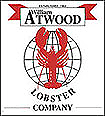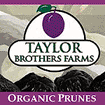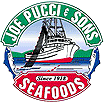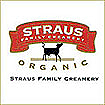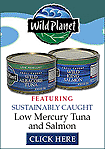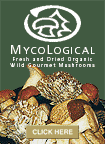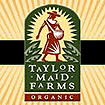
March
on Mercury - Have Your Sushi and Eat it Too - KidSafe Seafood
Recipes
March
On Mercury
Mercury in seafood has been a hot topic for the news media lately,
and now this debate has moved on to sushi, an increasingly popular
finger food that many children love.
KidSafe
Seafood, a SeaWeb program, dedicates our March e-newsletter
to helping parents eliminate mercury from their family's diets.
With KidSafe
Seafood Best Choices, you can have your sushi and
eat it too. So, put your best foot forward and join our march
against mercury. And please
share this e-newsletter with friends and family to
let them know that you are thinking about them and wish them
good health.
Mercury
Q and A with Tim Fitzgerald of the Environmental Defense Fund
Mercury in the Food Chain
Sushi Buyer's Guide
History of Sushi
Inspiring Asian Activities
Sayonara, Mercury! Host a Sustainable Sushi Party
*
Lemon-mint
Tea
* Boiled
Edamame Beans
* Wild
Alaskan Smoked Salmon Sushi Roll
* Imitation
Crab Roll
* Green
Tea Soy Ice Cream with Garnish
* Shopping
List and Party Planner
Mercury
Q and A with Tim Fitzgerald of the Environmental Defense Fund
Photo from edf.org
Tim
Fitzgerald, Environmental Defense Fund Scientist, analyzes the
sustainability of fisheries and aquaculture operations to provide
information about eco-friendly seafood choices, often in collaboration
with other conservation organizations such as SeaWeb's KidSafe
Seafood program. Fitzgerald researches the occurrence of mercury,
PCBs, dioxins and pesticides in fish as a means of educating
consumers and policymakers about the health risks associated
with the consumption of contaminated seafood. Fitzgerald is
a frequent speaker on conservation and human health issues concerning
the U.S. seafood market.
Q:
What is mercury and where is it found?
A: Mercury is a highly toxic metal that is
both naturally occurring and introduced to the environment by
industrial processes. Coal-fired power plants account for two-thirds
of global mercury emissions.
Q:
How does mercury get into our seafood?
A: After it enters the atmosphere, mercury
falls to the ground and enters bodies of water. There, it is
converted by bacteria into methylmercury, the form that accumulates
in fish and poses a risk to human health.
Q:
What are the major risks and potential effects of eating seafood
that is high in mercury?
A: Mercury targets the nervous system and kidneys.
Children exposed to mercury before birth may exhibit problems
with mental development and coordination, including how they
think, learn and problem-solve later in life.
Mercury
exposure can also harm adults. Symptoms can include numbness,
burning or tingling of the extremities, fatigue, weakness, irritability,
shyness, loss of memory and coordination, tremors and changes
in hearing and blurred vision.
Q:
Who is most susceptible to mercury?
A: Developing fetuses, infants and young children
are at the highest risk from mercury exposure, since their brains
and nervous systems are still forming. Fetuses can absorb mercury
directly across the placenta, and nursing infants can get it
from their mother's breast milk. This is why it is so important
for women of childbearing age to minimize their consumption
of fish with high mercury levels.
Q: What seafood is safe for pregnant mothers
and children to eat?
A: It's best to focus on small fish that are
lower on the food chain. Anchovies, Arctic char, Atlantic mackerel,
wild Alaskan salmon (including canned), sardines and farmed
trout are all low in mercury and great sources of omega-3.
Q:
If a person or child is tested and has a high level of mercury
in their body, how long will it take for them to return back
to having safe levels of mercury in their body?
A: The good news is that mercury levels in
your body will gradually decrease over time, assuming you don't
eat any more mercury-contaminated fish. You should start to
see a difference in a few months.
Q:
What are some of the other toxic pollutants that are found in
certain seafood and what are their effects?
A: Mercury is the most prevalent environmental
pollutant found in seafood, but there are others that can be
a problem too. PCBs, dioxins, pesticides and flame-retardants
(PBDEs)-probable human carcinogens-have all been found at elevated
levels in commercially available fish. They tend to be a more
localized issue, so the best way to avoid exposure is to check
recreational fishing advisories before eating locally caught
fish.
Q:
What is the best way to avoid environmental pollutants in seafood?
A: Here are three easy ways to minimize your
exposure to seafood contaminants:
1. Carry
a seafood guide that lists healthy and eco-friendly options,
like Environmental
Defense's Seafood Selector and the KidSafe
Seafood Best Choices Chart.
2. Eat
fewer large, predatory fish like swordfish, shark and tuna,
which are likely to be highest in mercury and other toxins.
Instead, choose smaller fish that are lower on the food chain,
like canned salmon, sardines, catfish and farmed shellfish.
3. Eat
a variety of fish. Just like you wouldn't invest all your money
in one stock, mixing up your seafood choices lessens your risk
of excessive mercury exposure from one highly contaminated species.
Mercury
in the Food Chain
Information from the Natural Resources Defense Council Web site
at NRDC.org
Graphic from the Environmental Defense Fund Web site at edf.org
Chlorine
chemical plants and coal-fired power plants are the two of the
largest sources of human-caused mercury contamination on our
planet. Mercury is used as a catalyst in the chlorine manufacturing
process, and mercury is also found in coal, where it escapes
in untreated smoke from coal-fired plants. Many countries rely
on these chemicals for fuel or other commodities, which makes
it hard to combat mercury contamination.
Coal-fired
power plants provide China with 75 percent of its energy. And,
in some countries, mercury is used to mine gold. Also, mercury
is commonly found in electrical switches, batteries and measuring
devices like thermometers.
In developed countries, many plants have already shifted to
cleaner technology that drastically reduces the output of mercury
into the atmosphere. However, some countries, such as China
and India, don't have the environmental standards to force plants
to add the more expensive, cleaner technologies to reduce mercury
output. Because mercury can travel long distances in the atmosphere,
this affects everyone on the planet. Mercury released into the
air in China, for example. can find its way to any place in
the world.
For
more information, visit the Natural
Resources Defense Council.
Sushi
Buyer's Guide
Photo from homepage 3.nifty.com
According
to the Natural Resources Defense Council, women who are pregnant
or planning to become pregnant should be especially careful
about eating sushi. Many of the fish chosen for sushi are the
top predators in the fish food chain. In other words, because
they eat other fish that can contain mercury, they can accumulate
high concentrations of mercury in their bodies. This
list highlights sushi choices highest and lowest
in mercury.
History
of Sushi
Information adapted from eatsushi.com
and sushifaq.com
Photo from growabrain.typepad.com
Sushi
came from very basic beginnings. During the seventh century,
Southeast Asian countries such as Vietnam, Laos and Myanmar
brought a method of long-term fish storage to Japan that relied
heavily on rice. The fish were packed in rice from two months
to a year. As the fish fermented, the rice produced lactic acid,
which then pickled the fish. Unfortunately, the rice was soppy
and sour. So, it was cast aside as a waste product.
The
slow pickling process was eventually replaced by a more updated
method that kept the rice edible. Around the 17th century in
Japan, rice wine vinegar was added to the fish and rice combination.
The vinegar accentuated the sourness of the fermented rice,
leaving a very palatable ball of rice after the fermenting process.
The vinegar also drastically shortened the fermentation process
to a matter of days instead of months or years.
During
the 1820s, a man named Hanaya Yohei started placing a piece
of fresh fish atop an oblong shaped piece of seasoned rice,
which is referred to as "nigiri" and still wildly
popular everywhere sushi is eaten.
Today,
sushi continues to evolve, and sushi restaurants can be found
in around the world. The taste and health benefits of sushi
ensure its place as a staple of many people's diet for years
to come. Children love dipping the bite-sized pieces in soy
sauce and popping them into their mouths. They also have fun
eating them with chopsticks. It's a great way to introduce lean
proteins like seafood into their diets.
Inspiring
Asian activities
Photo from picasaweb.google.com
Fun,
beginner-level origami from origami.com
* Create
a boat
* Create
an elephant
* Create
a fox
Tai
Chi classes are great for people of all ages, grandchildren
to grandmothers. Find
a Tai Chi instructor near you.
Sayonara,
Mercury! Host a Sustainable Sushi Party
Photo from allrecipes.com
You
can have your sushi and eat it too. Below, KidSafe Seafood
has designed a multi-course meal that is delicious, sustainable
and easy to prepare.
*
In-depth
text tutorial on how to make sushi rolls
* Video
tutorial from YouTube.com on how to make California sushi rolls
Recipes:
* Lemon-mint
Tea
* Boiled
Edamame Beans
* Wild
Alaskan Smoked Salmon Sushi Roll
* Imitation
Crab Roll
* Green
Tea Soy Ice Cream with Garnish
* Shopping
List and Party Planner

SeaWeb Quick Links:
If
you would like some more recipes to make in your galley at home,
please check our Web site recipe section
To
enjoy other SeaWeb newsletters, log into your account
Visit
SeaWeb's Web site if you have forgotten your password










